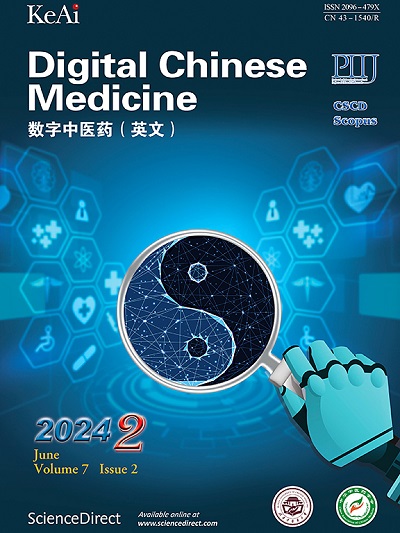利用 UPLC-Q-TOF-MS 鉴定娟旦百合不同部位的代谢物及其降血糖活性
Q3 Medicine
引用次数: 0
摘要
目的采用超高效液相色谱-四极杆飞行时间质谱(UPLC-Q-TOF-MS)技术鉴定牡丹百合不同部位提取物中的主要成分,并考察其降血糖活性。方法对牡丹花百合主要成分的质谱破碎途径进行研究,并采用质谱破碎途径结合质谱挖掘技术对其提取物中的主要成分进行系统鉴定。以链脲佐菌素(80 mg/kg灌胃3 d)诱导的高血糖雄性小鼠模型[SPF级昆明小鼠]为研究对象,通过测定小鼠血糖、日摄食量、日摄食量和体重的变化,评价红花百合(Lilium lancifolium)根、茎、球茎、叶、花的降血糖作用。结果明确了牡丹百合中雷公苷、薯蓣皂苷、苯丙素、黄酮类化合物和绿原酸的质谱裂解途径,建立了百合中化合物的提取方法。从牡丹花百合的根、茎、球茎、叶和花中共鉴定出58种化合物,包括6种绿原酸、14种雷甲苷、13种苯丙素、5种黄酮类化合物和20种薯蓣皂苷。其中30个化合物为首次从该植物中分离得到。根和球茎提取物具有显著的降糖作用,可将血糖水平分别从23.76±1.21和24.29±1.35 mmol/L降至17.21±1.23和18.78±1.49 mmol/L (P <;0.05)。根和球茎提取物也能减轻烦渴症状(P <;0.01),多食症(P <;0.05),糖尿病引起的体重下降。结论本研究首次阐明了牡丹花百合(Lilium lancifolium)的根中含有丰富的雷王皂苷和薯蓣皂苷,具有显著的降糖活性,为该植物的综合利用和降糖药物的开发提供了基础。本文章由计算机程序翻译,如有差异,请以英文原文为准。
Identification of metabolites in different parts of Juandan Baihe (Lilium lancifolium) by UPLC-Q-TOF-MS and their hypoglycemic activities
Objective
To identify the main components in the extracts of different parts of Juandan Baihe (Lilium lancifolium) by ultra-high performance liquid chromatography quadrupole time-of-flight mass spectrometry (UPLC-Q-TOF-MS) technology and investigate their hypoglycemic activities.
Methods
The MS fragmentation pathways of the main types of compounds in Juandan Baihe (Lilium lancifolium) were studied, and the main components in the extracts were systematically identified using MS fragmentation pathways combined with MS mining technology. Based on the hyperglycemia male mouse model [specific pathogen free (SPF)-grade Kunming mice] induced by streptozotocin (intragastric administration of 80 mg/kg for 3 d), the hypoglycemic effects of extracts of Juandan Baihe (Lilium lancifolium) roots, stems, corms, leaves, and flowers were evaluated by measuring the changes of blood glucose, daily water consumption, daily food intake, and body weight.
Results
The MS fragmentation pathways of regalosides, dioscins, phenylpropanoids, flavonoids, and chlorogenic acids in Juandan Baihe (Lilium lancifolium) were clarified, and a mining method for compounds in this plant was constructed. A total of 58 compounds, including 6 chlorogenic acids, 14 regalosides, 13 phenylpropanoids, 5 flavonoids, and 20 dioscins, were identified from the roots, stems, corms, leaves, and flowers of Juandan Baihe (Lilium lancifolium). Among them, 30 compounds were reported for the first time from this plant. The root and corm extracts demonstrated significant hypoglycemic activities by reducing blood glucose levels from 23.76 ± 1.21 and 24.29 ± 1.35 mmol/L to 17.21 ± 1.23 and 18.78 ± 1.49 mmol/L, respectively (P < 0.05). The roots and corms extracts could also attenuate the symptoms of polydipsia (P < 0.01), polyphagia (P < 0.05), and weight loss caused by diabetes.
Conclusion
This study clarifies that the roots of Juandan Baihe (Lilium lancifolium) are rich in regalosides and dioscins for the first time, and have significant hypoglycemic activities, providing the foundation for the comprehensive utilization of this plant and the development of hypoglycemic drugs.
求助全文
通过发布文献求助,成功后即可免费获取论文全文。
去求助
来源期刊

Digital Chinese Medicine
Medicine-Complementary and Alternative Medicine
CiteScore
1.80
自引率
0.00%
发文量
126
审稿时长
63 days
期刊介绍:
 求助内容:
求助内容: 应助结果提醒方式:
应助结果提醒方式:


